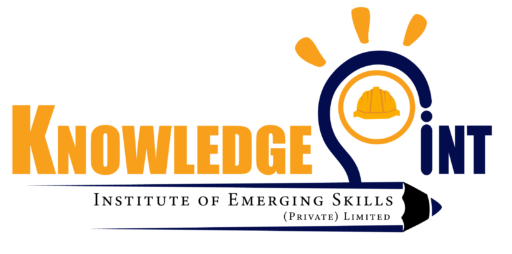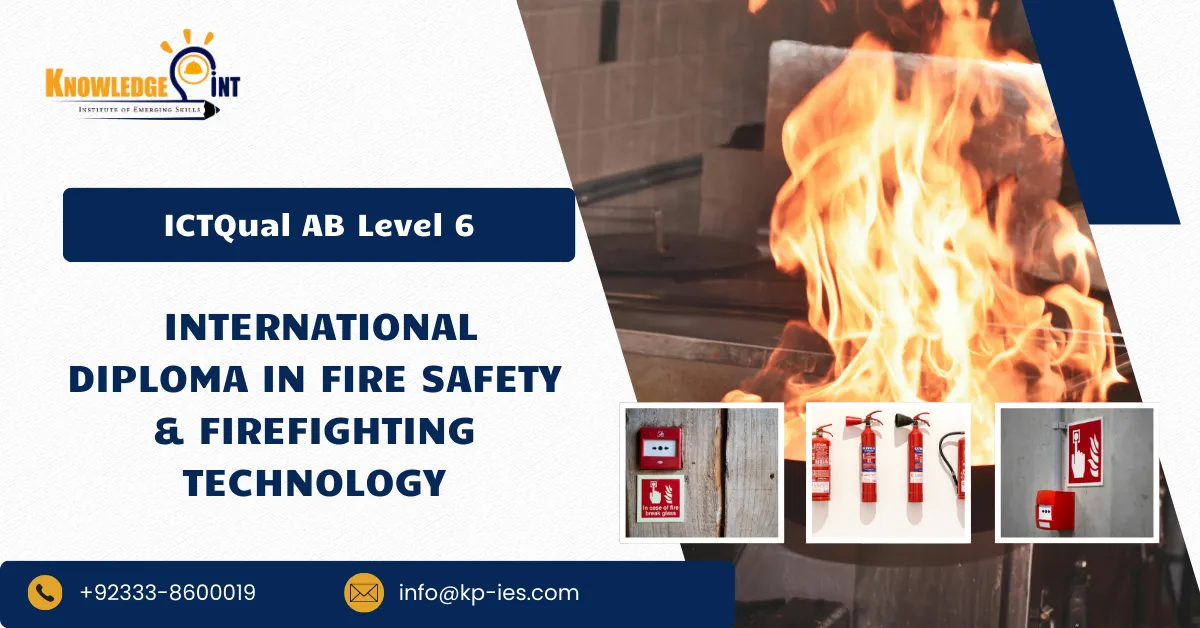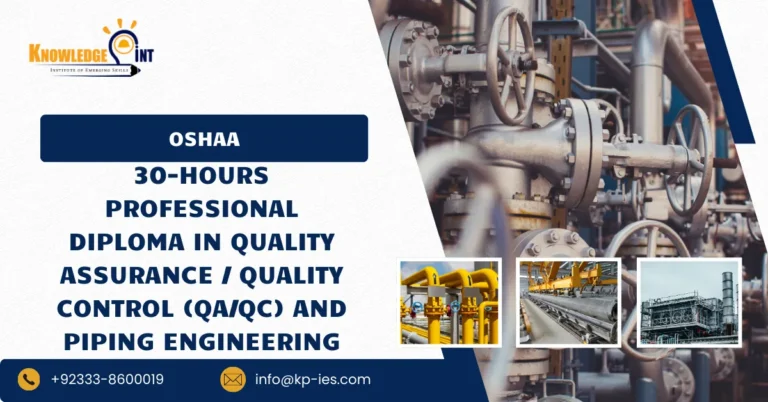The ICTQual AB Level 6 International Diploma in Fire Safety & Firefighting Technology is an advanced three-year, 360-credit programme designed to provide learners with comprehensive knowledge, practical skills, and strategic expertise in fire safety, fire prevention, and firefighting operations. This internationally recognised qualification is ideal for both freshers aiming to enter the fire safety sector and professionals seeking to enhance their technical competence and leadership capabilities in safety management.
Learners will explore a wide range of topics including fire science, fire dynamics, risk assessment, emergency response, fire prevention strategies, firefighting equipment, and industrial fire protection systems. The programme integrates theoretical instruction with hands-on training, practical simulations, laboratory exercises, and project-based learning, ensuring learners gain the skills needed to assess, prevent, and manage fire-related hazards in diverse environments.
The qualification offers significant professional value by preparing learners for critical roles in fire safety management, emergency response, industrial safety, and risk assessment. Graduates acquire the expertise to develop and implement effective fire prevention strategies, conduct fire risk assessments, and operate firefighting systems safely and efficiently.
Course Overview
This qualification, the ICTQual AB Level 6 International Diploma in Fire Safety & Firefighting Technology, consists of 36 mandatory units.
Year 1 – Foundation in Fire Safety & Firefighting Technology
- Principles of Fire Science and Combustion
- Introduction to Fire Safety Management
- Fire Dynamics and Behaviour
- Fire Prevention and Hazard Identification
- Basics of Firefighting Equipment
- Health, Safety, and Environmental Awareness
- Fire Risk Assessment Fundamentals
- Emergency Response Planning
- Laboratory Techniques in Fire Safety
- Technical Report Writing
- Introduction to Fire Safety Regulations and Standards
- Fire Simulation and Safety Software Basics
Year 2 – Intermediate Fire Safety & Firefighting Technology
- Advanced Fire Risk Assessment Techniques
- Fire Detection and Alarm Systems
- Fire Suppression Systems and Methods
- Industrial Fire Safety Management
- Fire Safety in High-Risk Environments
- Emergency Evacuation Planning and Procedures
- Process Control and Safety Automation
- Data Analysis and Fire Incident Investigation
- Project Planning and Technical Communication
- Quality Control and Assurance in Fire Safety
- Advanced Laboratory Experiments in Fire Safety
- Fire Safety Compliance and Regulatory Standards
Year 3 – Advanced Fire Safety & Firefighting Technology
- Advanced Firefighting Techniques and Strategies
- Fire Safety Project Management
- Fire Behaviour Modelling and Simulation
- Hazardous Materials and Industrial Fire Protection
- Emergency Response Leadership and Coordination
- Risk Assessment and Safety Decision-Making
- Fire Safety in Large-Scale Facilities and Complex Sites
- Advanced Laboratory Techniques and Field Testing
- Supply Chain and Logistics in Fire Safety Operations
- Capstone Project in Fire Safety & Firefighting Technology
- Professional Development and Leadership in Safety Management
- Strategic Decision-Making in Fire Safety and Emergency Operations
Learning Outcomes for the ICTQual AB Level 6 International Diploma in Fire Safety & Firefighting Technology:
Year 1 – Foundation in Fire Safety & Firefighting Technology
Principles of Fire Science and Combustion
- Understand the chemistry and physics of fire, including combustion processes.
- Analyse fire behaviour under different conditions.
- Apply fire science principles to practical safety measures.
Introduction to Fire Safety Management
- Learn the fundamentals of fire safety planning and management.
- Understand roles and responsibilities in fire safety operations.
- Implement basic strategies for workplace and industrial fire safety.
Fire Dynamics and Behaviour
- Examine fire growth, spread, and heat transfer mechanisms.
- Analyse factors influencing fire intensity and development.
- Apply fire dynamics knowledge to safety and prevention strategies.
Fire Prevention and Hazard Identification
- Identify common fire hazards in industrial and commercial settings.
- Implement preventive measures to minimise fire risks.
- Conduct basic hazard assessments to inform safety planning.
Basics of Firefighting Equipment
- Understand the function and operation of firefighting tools and systems.
- Apply equipment knowledge in controlled training scenarios.
- Ensure proper maintenance and readiness of firefighting apparatus.
Health, Safety, and Environmental Awareness
- Learn key health and safety principles relevant to Fire Safety & Firefighting Technology.
- Understand environmental impacts of fire and firefighting.
- Implement safe practices in all fire safety operations.
Fire Risk Assessment Fundamentals
- Conduct basic fire risk assessments in various settings.
- Identify potential hazards, evaluate risks, and recommend controls.
- Prepare foundational risk assessment reports.
Emergency Response Planning
- Develop emergency response strategies for fire incidents.
- Plan evacuation procedures and resource allocation.
- Coordinate initial emergency response efforts effectively.
Laboratory Techniques in Fire Safety
- Conduct controlled experiments to analyse fire behaviour.
- Record and interpret experimental data.
- Apply laboratory results to practical safety solutions.
Technical Report Writing
- Develop skills to produce professional fire safety reports.
- Present data, analysis, and recommendations clearly.
- Apply proper formatting, referencing, and technical writing conventions.
Introduction to Fire Safety Regulations and Standards
- Understand local and international fire safety regulations.
- Apply standards to ensure compliance in practical scenarios.
- Evaluate safety policies and procedures against regulatory requirements.
Fire Simulation and Safety Software Basics
- Gain basic proficiency in fire simulation and modelling tools.
- Analyse potential fire scenarios using software applications.
- Apply simulation results to improve fire safety planning.
Year 2 – Intermediate Fire Safety & Firefighting Technology
Advanced Fire Risk Assessment Techniques
- Conduct in-depth fire risk assessments for complex environments.
- Implement quantitative and qualitative assessment methods.
- Recommend advanced control measures based on assessment outcomes.
Fire Detection and Alarm Systems
- Understand principles of fire detection and alarm technologies.
- Analyse system performance and reliability.
- Implement appropriate detection and warning strategies.
Fire Suppression Systems and Methods
- Learn advanced fire suppression techniques, including sprinkler and gas systems.
- Evaluate effectiveness in different scenarios.
- Apply suppression methods safely and efficiently.
Industrial Fire Safety Management
- Manage fire safety programmes in industrial and commercial facilities.
- Monitor compliance and performance of safety systems.
- Integrate fire safety planning with operational processes.
Fire Safety in High-Risk Environments
- Identify hazards in chemical plants, oil & gas, and other high-risk sites.
- Develop tailored fire safety strategies.
- Implement mitigation and emergency response plans.
Emergency Evacuation Planning and Procedures
- Design comprehensive evacuation plans.
- Coordinate drills and emergency response exercises.
- Ensure effective communication during emergencies.
Process Control and Safety Automation
- Integrate automated safety systems in industrial operations.
- Analyse control processes for reliability and efficiency.
- Optimise safety automation to prevent fire incidents.
Data Analysis and Fire Incident Investigation
- Analyse data from fire incidents to identify causes.
- Prepare incident investigation reports with recommendations.
- Apply findings to prevent future occurrences.
Project Planning and Technical Communication
- Plan and manage fire safety projects.
- Communicate technical information clearly to stakeholders.
- Apply project management principles to ensure timely completion.
Quality Control and Assurance in Fire Safety
- Monitor and evaluate fire safety systems and processes.
- Implement quality assurance techniques to ensure standards compliance.
- Conduct audits and inspections to verify system performance.
Advanced Laboratory Experiments in Fire Safety
- Perform complex laboratory simulations and tests.
- Analyse results to validate fire safety models.
- Apply experimental findings to practical scenarios.
Fire Safety Compliance and Regulatory Standards
- Interpret advanced regulations and industry standards.
- Ensure operational compliance in all fire safety activities.
- Develop strategies to maintain continuous regulatory adherence.
Year 3 – Advanced Fire Safety & Firefighting Technology
Advanced Firefighting Techniques and Strategies
- Master advanced methods for fire suppression in diverse scenarios.
- Apply tactical decision-making in high-pressure situations.
- Integrate knowledge of fire dynamics with practical firefighting.
Fire Safety Project Management
- Lead large-scale fire safety projects.
- Coordinate teams, resources, and timelines efficiently.
- Evaluate project outcomes and implement continuous improvement strategies.
Fire Behaviour Modelling and Simulation
- Apply modelling techniques to predict fire spread and impact.
- Analyse simulation results for planning and prevention.
- Optimise safety strategies using predictive tools.
Hazardous Materials and Industrial Fire Protection
- Identify risks associated with hazardous substances.
- Implement specialised protection systems for industrial environments.
- Apply emergency response techniques specific to hazardous materials.
Emergency Response Leadership and Coordination
- Lead multidisciplinary teams during fire emergencies.
- Develop coordination protocols for rapid and effective responses.
- Evaluate and improve emergency response strategies.
Risk Assessment and Safety Decision-Making
- Conduct comprehensive risk assessments in complex scenarios.
- Apply analytical frameworks for strategic safety decisions.
- Recommend measures to minimise fire risks in industrial operations.
Fire Safety in Large-Scale Facilities and Complex Sites
- Manage fire safety in factories, refineries, and commercial complexes.
- Develop operational plans for multi-level facilities.
- Implement monitoring and compliance strategies effectively.
Advanced Laboratory Techniques and Field Testing
- Conduct advanced experiments and field tests.
- Validate fire safety systems and operational protocols.
- Analyse results for optimisation and compliance purposes.
Supply Chain and Logistics in Fire Safety Operations
- Understand procurement, distribution, and maintenance of fire safety equipment.
- Optimise logistics for emergency preparedness.
- Integrate supply chain management with operational safety planning.
Capstone Project in Fire Safety & Firefighting Technology
- Undertake a comprehensive, real-world fire safety project.
- Demonstrate integration of all theoretical and practical knowledge.
- Present findings and solutions professionally.
Professional Development and Leadership in Safety Management
- Develop leadership, teamwork, and communication skills.
- Prepare for senior roles in fire safety and emergency management.
- Apply strategic planning and operational oversight in professional contexts.
Strategic Decision-Making in Fire Safety and Emergency Operations
- Make informed, high-level decisions in fire safety management.
- Evaluate risks, operational constraints, and resources strategically.
- Implement policies and procedures for long-term fire safety optimisation.
Course Benefits of ICTQual ABLevel 6 International Diploma in Fire Safety & Firefighting Technology
Advanced Fire Safety Knowledge
- Equips learners with in-depth understanding of fire science, fire dynamics, and modern firefighting technologies.
- Covers fire prevention, risk assessment, fire protection systems, and emergency planning to ensure workplace and public safety.
Technical & Practical Competence
- Develops proficiency in firefighting equipment, suppression techniques, and the application of advanced fire protection technologies.
- Strengthens skills in incident command, hazardous materials handling, and disaster management.
Compliance & Risk Management
- Prepares learners to interpret and apply international fire safety standards, codes, and regulations.
- Builds strong competencies in risk analysis, mitigation strategies, and safety auditing.
Career Advancement
- Enhances employability in fire services, safety consultancy, industrial safety management, and emergency response organizations.
- Opens opportunities for supervisory and managerial positions in safety and firefighting sectors.
Global Relevance
- Designed to meet international fire safety and firefighting requirements, providing recognition in multiple regions and industries.
- Addresses emerging challenges in fire safety such as high-rise building fires, industrial hazards, and smart firefighting technology.
Hands-On Application
- Emphasizes practical exercises, case studies, and simulations to ensure readiness for real-world firefighting and fire safety management.
After completing this course, learners can progress in the following ways:
- Academic Progression
- Eligible learners can progress to Level 7 Postgraduate Diplomas in Fire Safety Engineering, Disaster & Risk Management, or Occupational Health & Safety.
- Provides entry routes into Master’s degrees (MSc in Fire Safety Engineering, MSc in Risk & Emergency Management, MSc in Occupational Safety & Health Management) at international universities.
- Professional Development
- Supports learners aiming for professional memberships with fire safety and engineering bodies (e.g., Institution of Fire Engineers – IFE).
- Prepares individuals for advanced certifications in safety auditing, emergency planning, and industrial fire risk management.
- Career Pathways
Graduates may advance into roles such as:- Fire Safety Engineer / Specialist
- Fire Officer / Fire Protection Manager
- Health, Safety & Fire Risk Consultant
- Industrial Safety Supervisor / Manager
- Emergency Response Coordinator
- Disaster Management Specialist
- Global Opportunities
- Opens career prospects in fire departments, oil & gas industries, aviation, construction, manufacturing, and government agencies.
- Supports roles in international safety consultancies, firefighting technology firms, and disaster management organizations.







